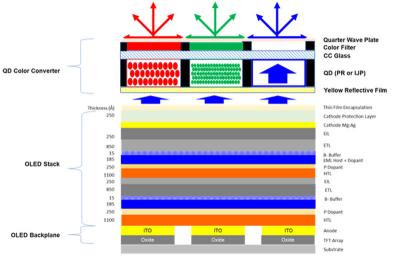QD-OLED displays - Page 11
DSCC: the production costs of a 55" QD OLED TV will reach almost $800 in 2019, will fall to $450 by 2022
DSCC says that production costs for a 55" QD-OLED TV panel at Samsung Display's 8.5-Gen fab will reach almost $800 in 2019. While this will fall to around $450 in 2022, Samsung will still lose money on every panel sold if DSCC has its price and cost estimates right.

It is important to note that most of the cost is depreciation costs - which means that in terms of cash on each panel, SDC's margins will actually be around 40%. Part of the reason for he high cost of required equipment is the need to use 12 TFT masks.. SDC is apparently looking to reduce the mask number which will lower production costs.
Samsung reports its Q4 2018 financial results - lower OLED revenues, demand will pick up in H2 2019
Samsung Electronics reported its financial results for Q4 2018, with revenues of KRW 59.27 trillion ($53 billion USD), down 10% from Q4 2017. Samsung's operating profit of KRW 10.8 trillion ($9.6 billion) was down 29% from 2017.

Samsung Display reported a decline in rigid smartphone OLED display sales - due to rising competition from LCD panels. Demand for flexible OLEDs was strong. In Q1 2019, OLED display sales will remain weak - but Samsung says that flexible OLED demand will pickup in the second half of 2019.
Nanosys expects to show working emissive QD-LED displays by the end of 2019
HDTVTest posted an interesting interview with Cadmium-Free QD developer Nanosys CEO and president Jason Hartlove. In this long interview Jason discusses the company's technology and recent achievements.
Jason reveals that the company is working on emissive Quantum Dots displays - and he expects to have a full-color monitor-size QLED display prototype ready by the end of 2019. Jason says that they hope to show these display prototypes in private demos at CES 2020.
Samsung progresses with its inkjet printing OLED technology, to apply it to next-generation monitors and laptops
According to ETNews, Samsung Display has made significant progress with its OLED ink-jet printing process technology, and the company now aims to apply this technology to produce medium-sized panels for OLED laptops and OLED monitors. Samsung may also use this process to produce smaller tablet displays.

It seems that Samsung is aiming to settle on three main next-generation OLED technologies - evaporation (FMM) OLEDs for small-sized display, ink-jet OLED deposition for medium-sized panels and hybrid QD-OLEDs for large-area OLED TV panels. It's other display technologies are QD-LEDs for TVs and Micro-LEDs for next-generation small and large area displays.
More details emerge on Samsung's QD-OLED TV Plans
Samsung Display is developing hybrid QD-OLED TV technology, and according to estimates, the company aims to begin trial production in 2019. It seems that Samsung is managing to overcome the technical challenges and the company is preparing to start production of such QD-OLED TVs in 2019.

Last month Digitimes updated about Samsung's plans to start installing equipment by the end of 2018 and begin trial production in H2 2019. Digitimes now posted another article, revealing more details on Samsung's plans.
Digitimes details Samsung's QD-OLED TV production plans and equipment
Samsung Display is developing hybrid QD-OLED TV technology, and according to estimates, the company aims to begin trial production in 2019. It is also estimated that Samsung has several challenges to overcome, but according to new reports from Digitimes, Samsung is aiming to start installing equipment for the new fab as early as December 2018.

The new fab will begin operation in the second half of 2019 - pilot production at first which will be expanded to full scale mass production. The new fab will be built in Samsung's L8 LCD production line in Asan, and will take over one of the two lines currently in operation at the fab. Samsung's initial production capacity will be around 25,000 monthly G8 substrates.
Reports from Korea estimate SDC's QD-OLED investments at $8.8 billion between 2019 and 2021
In April 2018 Samsung announced it is developing QD-OLEDs (hybrid Quantum Dots - OLED) TVs. Later reports suggested that the company is building its first production line, with aims to begin pilot production in 2019.

According to a new report from Korea, if Samsung's initial QD-OLED development is successful, it plans to convert an existing LCD line (SDC's 8-Gen L8-1 line) to QD-OLED production in 2020. Samsung's projected investment in its QD-OLED production will exceed $8.8 billion between 2019 and 2021.
DSCC: Samsung to begin pilot QD-OLED production in 2019
DSCC estimates that Samsung will begin pilot production of QD-OLEDs in 2019, with a capacity of 5,000 monthly 8.5-Gen substrates. If this is successful, Samsung will double the capacity in 2020 and add a further 30,000 yearly substrates in 2021 and again in 2022. Material revenues for Samsung's QD-OLED TVs will reach $56 million in 2022.

DSCC admits, though, that as Samsung faces several technical challenges before it could launch commercial QD-OLED TVs, its forecast could be way off - there's a good chance that SDC will cancel the project, or it could increase capacity at a much faster rate than DSCC estimates and even scale-up production to 10.5-Gen.
DSCC lowers its OLED revenue forecast for 2019-2022, sees the market at $50 billion in 2022
Display Supply Chain Consultants (DSCC) updated its AMOLED market forecast, and the company now expects revenues to grow from $26 billion in 2018 to $50 billion in 2022.

DSCC sees fast growth for the OLED market, driven by flexible and foldable displays - and the flexible OLED market will grow at a 32% CAGR from 2018 to 2022. Only a few months ago, though, DSCC estimated that revenues in 2022 will reach $57.2 billion by 2022.
DSCC updates its display equipment market forecast, says recovery is not expected until 2022
Display Supply Chain Consultants (DSCC) updated its display equipment spending forecasts, and the company now expects OLED spending to recover only in 2022. In June 2018, DSCC estimated that the OLED equipment market will start to recover in 2020.

DSCC says that the whole display market is currently saturated after unprecedented equipment spending in 2016-2018 (an average of $22 billion per year for both LCDs and OLEDs) - for both mobile display and TV display production. Display production is expected to grow at 10% per year from 2018-2020 (as a result of the equipment orders in 2016-2018), and combined with lower operation margins and losses in the display market are causing display makers to be cautious with new capacity plans.
Pagination
- Previous page
- Page 11
- Next page



